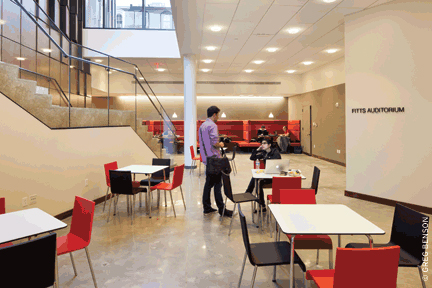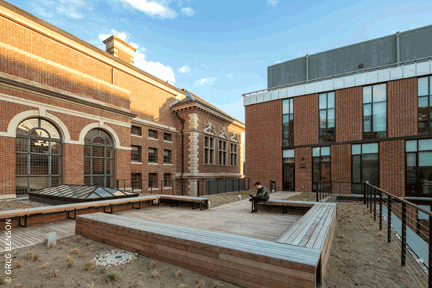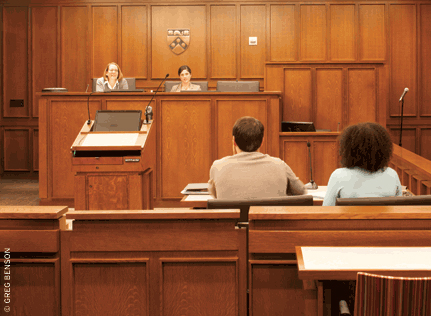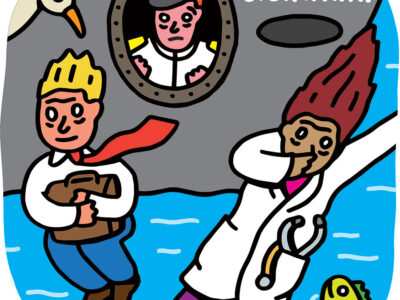
Though students and faculty had been cruising its light-splashed hallways since February, the Law School’s newest building was formally dedicated on April 5, with US Supreme Court Justice Sonia Sotomayor on hand to cap off the celebration.
Golkin Hall, named in honor of Perry Golkin W’74 WG’74 L’78 and Donna Golkin WG’77, has replaced the former Pepper Hall on the Sansom Street side of the Penn Law quadrangle. The new building features three times the square footage as its one-story predecessor. It combines faculty and administrative offices, classroom spaces, a café and lounge area, a Moot Court room, and a signature 350-seat auditorium that gives the Law School, at long last, a teaching and special-event venue big enough to hold its entire student body and full-time faculty.

With its seamless connections with Silverman Hall to the east and Tanenbaum Hall to the west, Golkin Hall completes a thorough refurbishment of the Law campus that began in 2005 with enhancements to classrooms in Gittis Hall. It also responds to the substantial growth of the law faculty in recent years, and to the changing nature of law education.
“Our faculty has grown almost 50 percent over the last decade,” says Michael Fitts, the Law School Dean and Bernard G. Segal Professor of Law.
Concomitantly, “the nature of our teaching has changed,” he adds. “We have much more joint teaching, we have classes that are much smaller and more specialized, and the physical plant has had to transform to both provide a campus for this—many more classes, smaller classes—and an environment in which people from different areas and fields can connect with one another.”

Under the green-roof garden terraces, Golkin Hall’s seminar-sized classrooms are also tailored for Internet Age pedagogy.
“Classes have been taught here and in real time in Israel, or here and in real time on the West Coast,” says Fitts. “If you think of law as a field that totally connects up with every part of the world, and with every discipline, then the idea that you have joint teaching is central to who we are.”

At the dedication ceremony, held in a packed Irvine Auditorium, Fitts quoted Winston Churchill’s 1943 remark about rebuilding Britain’s Houses of Parliament after their destruction in World War II. “We shape our buildings,” the British Prime Minister said. “Thereafter, they shape us.”
Justice Sotomayor addressed a similar observation directly to the Golkins during the ceremony. It takes a “precious talent,” she said, “to recognize that physical structures can, in a very real sense, create history. They house the memories and emotions of the people who are nurtured in them. In turn they can inspire these individuals to reach out more boldly and meaningfully, as have the many graduates of this law school.”
A conversation between Fitts and Sotomayor—who were classmates at Yale Law School in the late 1970s—comprised the heart of the ceremony.
The Supreme Court justice talked about the genesis of her childhood dream to be a lawyer, which she dated to her diagnosis with juvenile diabetes as a seven-year-old. When her doctor’s office gave her a pamphlet outlining some of the careers that her condition would prevent her from pursuing, the young Nancy Drew fan’s “heart sunk” with the discovery that being a police detective was verboten. Being a lawyer, however, was included on a list of permissible jobs. And once she began watching Perry Mason, the young Sotomayor discovered that “lawyering involved a little bit of detective work, and I thought to myself, ‘Well, if I can’t be a detective detective, I can be a lawyer instead.’”
The justice also offered a “more complicated” account of the maturation of that childhood motivation, describing her quest—through public speaking and her high school debate team—to “find out whether I actually did like to argue, in a way that wasn’t just a childhood tantrum but in a way that was a more persuasive form. And I realized I did like those things.
“But as I went to college and I started to learn more about the law,” she continued, “what I realized is that, at the end, what the law is is service to people. No matter what kind of law you practice—whether it’s public or private, not-for-profit or for-profit, government or not—you’re helping people and institutions manage their relationships.
“The law gives us a framework,” she added. “We’re not arbitrators, and we’re not mediators, and we’re not psychologists. But we give [people] something outside themselves that helps measure their needs and their interests, and permits this society to function in a less controversial and a less violent way.”
Sotomayor answered questions about the value of clerking (calling her decision not to do so her only professional regret); the influence of her experience as a trial-court judge on her legal reasoning on the Supreme Court, where she is the lone member to have had such experience; the reasons she elected to become a prosecutor after law school rather than join a large firm; and the limitations Supreme Court justices face in enlightening the general public about the nature of their work. (The dedication occurred the week after the Court’s widely publicized oral arguments on the healthcare reform law, about which Sotomayor, like her colleagues, cannot speak.)
The dedication ceremony ended with an announcement by Fitts that a scholarship would be named in the Justice’s honor. Sotomayor accepted a commemorative framed certificate with uncommon grace.
“I went to college and law school on scholarships,” she said. “I didn’t come from a family who could have ever sent me there. I relied on the largesse of people like the Golkins, who created my American dream. And I’m so grateful to this school for passing it forward to someone else.”
—T.P.




